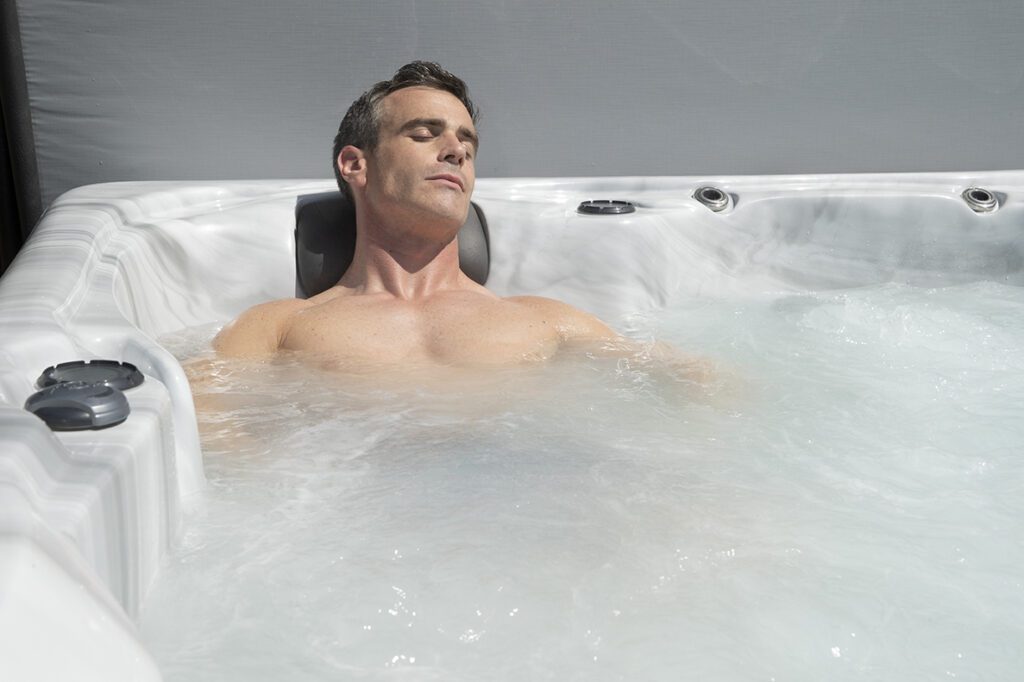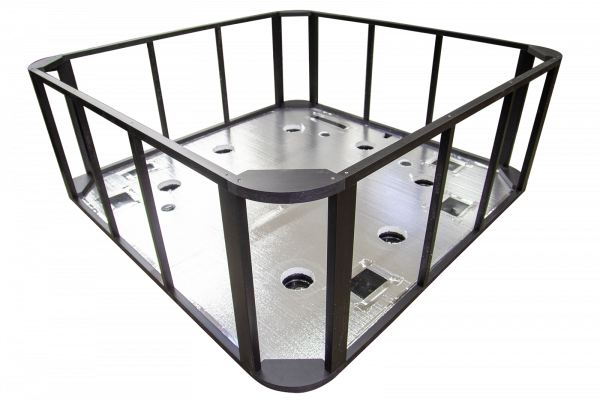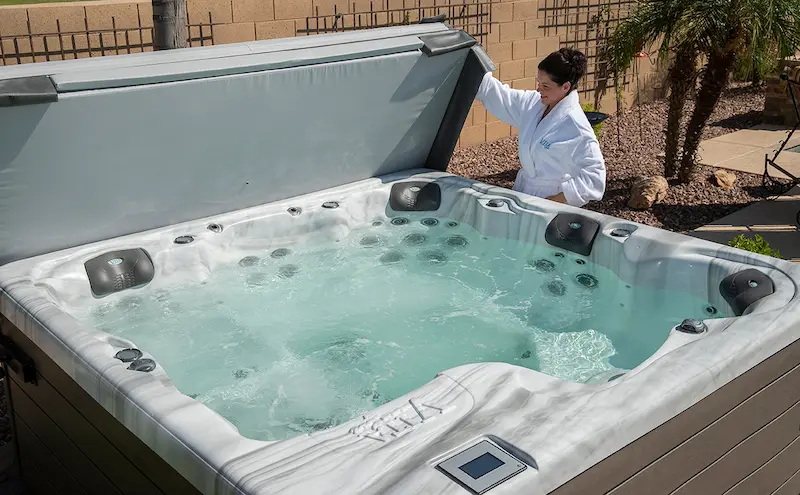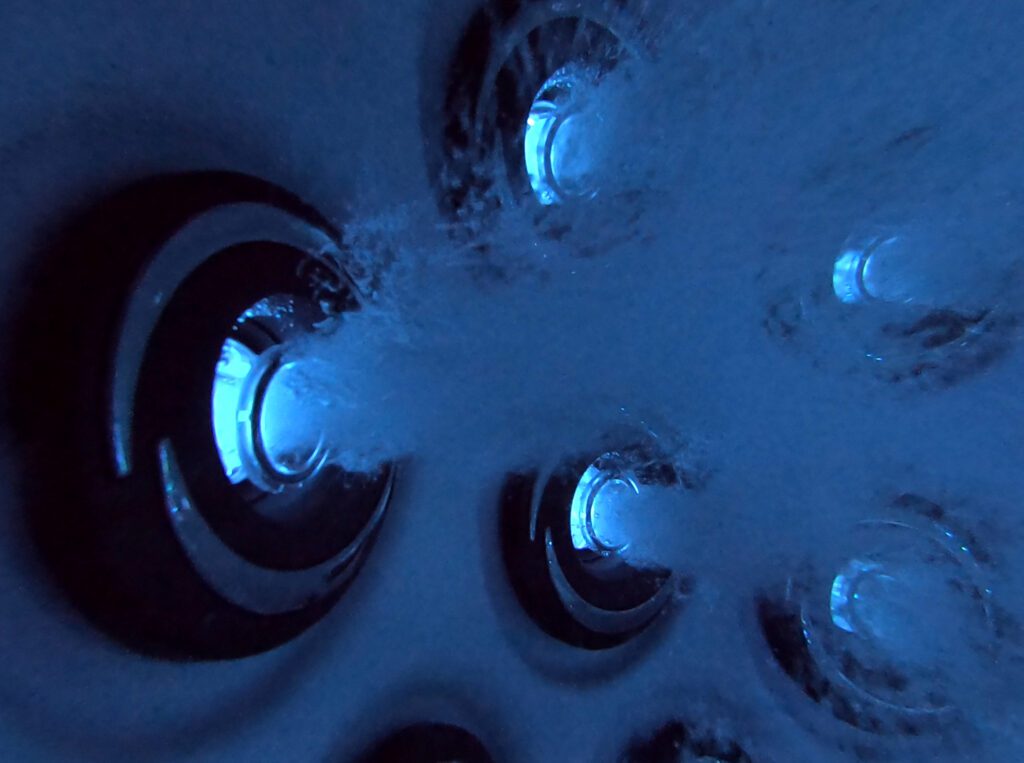For most people, buying a hot tub is no small investment. It requires careful consideration and planning— and let’s face it, it can be downright stressful! But with the right information, you can cut through the noise and focus on what really matters.
In this hot tub buying guide, we’ll help you zero in on the intel that will make all the difference throughout the purchase journey. From finding the right hot tub dealer to asking yourself the right questions before you buy, we’ve got the lowdown on the process.
Why should you take our word for it? After 15 years of service calls on all spa brands, we’ve seen firsthand who to trust and what to avoid.
So let’s dive into the hot tub buying guide so you can learn how to choose your best hot tub!

Table of Contents
Part 1: What to Look for When Buying a Hot Tub
When buying a hot tub, it’s important to focus on key factors that will help you identify a worthwhile investment from marketing hype.
1. Removable Hot Tub Insulation
Hot tub insulation directly affects a hot tub’s energy efficiency. This impacts how well it retains heat and how much it costs to run.
Why Does Insulation Matter?
- Energy Savings: Proper insulation minimizes heat loss, reducing the workload on your hot tub’s heater and lowering energy consumption.
- Year-Round Comfort: Whether it’s the peak of summer or the dead of winter, good insulation ensures consistent water temperatures without overburdening the system.
- Durability: High-quality insulation systems can protect internal components from temperature fluctuations, extending the lifespan of your hot tub.
- Maintenance: Removable insulation will enable maintenance techs to easily remove and replace insulation. Permanent spray or full-foam insulation can increase service costs.
What’s the Best Hot Tub Insulation?
The efficiency of a hot tub’s insulation system is measured by its R-Value, a rating system used to evaluate how well the insulation prevents heat from escaping. The higher the R-Value, the better the insulation system retains heat. The R-value of a hot tub depends on the insulation material and the thickness of the cover or foam.
From partial spray foam and thermal barriers to hybrid and full-foam insulation, there are plenty of choices when it comes to hot tub insulation. But which is the best?
- Full-Foam Insulation: Fills the hot tub cabinet with high-density foam for superior heat retention and structural support.
- Recycled Denim Insulation: Eco-friendly and effective, this material repurposes denim fibers for excellent thermal efficiency.
- Reflective Thermal Barriers: Utilizes foil-like layers to reflect heat back into the hot tub while blocking external cold.
- Spray Foam Insulation: Applied as a spray, this material seals gaps and provides consistent energy efficiency across the hot tub shell.
- Hybrid Insulation Systems: Combines multiple insulation types, such as foam and thermal barriers, for optimal performance in diverse climates.
Each type of insulation has its merits, but regardless of the material you choose, you’ll want to make sure it’s removable.

Just like any other appliance, being able to service a hot tub is paramount. This is achieved with the removable insulation such as open-celled foam insulation, which can be removed and re-installed quickly and still insulate very well.
Granted, full foam insulation is the most energy efficient option, but it makes maintenance more difficult, which significantly increases costs over time. Spray foam is also difficult to remove when repairs are necessary, and it’s almost never replaced. It just costs too much to do it.
When removable types are used, they wrap the whole perimeter of the hot tub so the entire cabinet is insulated. In most cases where spray foam is used, it’s not sprayed on the side where the electrical components are mounted. Typically, we find little to no insulation on this side where plumbing lines are exposed, and sometimes parts of the shell. That kind of defeats the purpose, doesn’t it?
Most hot tubs today are quite efficient, given that they actually have insulation in them. But don’t be fooled by a thin layer of bubble wrap, or a thin layer of spray foam. These types must be used in conjunction with another type of insulation to boast good energy efficiency.
Don’t be afraid to ask if you can see inside the cabinet of a hot tub that you’re interested in. Any salesperson should be happy to take the side off, and let you see inside. Would you advise buying a car without looking under the hood?
Hot Tub Buying Guide – Pro Tip: Avoid hot tubs with thin insulation, no insulation, or full foam spray insulation that can’t be replaced.
2. Easy-to-Find Hot Tub Parts
Before you get your heart set on any one brand name, look into the hot tub manufacturers’ components and reputation for quality. We’re talking about jets, fittings, heating & control systems, among other hot tub parts.
But the reason this is so important may not be what you think! Some manufacturers cut corners and build parts that are designed to fail. Sadly, that’s no surprise.
What is surprising, is that manufacturers can design parts that only fit their products, ensuring the quality is low and the failure rate is high. This means you’ll be stuck footing the bill for these repairs until you break down and buy a new hot tub from a different manufacturer.
This is called planned obsolescence— it’s something every hot tub buyer needs to be aware of.
Hot Tub Buying Guide – Pro Tip: Make sure the hot tub you’re considering uses quality components and has replacement parts that are easy to find at a fair price!
3. Fast & Friendly Hot Tub Dealers Near You
Believe it now or find out later: where you buy your hot tub matters! Why? The retailer you choose can make all the difference—not just during the purchase but throughout the lifespan of your spa. Here’s why:
- Trust and Reliability: A reputable dealer ensures you’re getting a high-quality product and honest advice. They’ll guide you to the right hot tub for your needs, without upselling features you don’t want or need.
- Convenience: Local retailers are often easier to reach, whether for showroom visits, delivery, or troubleshooting. Plus, having a nearby dealer saves time when you need parts or accessories.
- Relationship Over Time: A good hot tub dealer becomes a trusted partner, ready to assist with upgrades, tips, or questions long after your initial purchase.
- Services and Maintenance: Many dealers offer ongoing support, like water care consultations, maintenance plans, and warranty assistance. They can also perform routine checks to keep your hot tub running smoothly.
- Peace of Mind: Buying from a reliable source means you don’t have to worry about unknowns, like questionable construction, incomplete warranties, or lack of after-sales support.
A trusted local retailer is as important as choosing the right hot tub itself—both contribute to your long-term satisfaction and enjoyment.
Questions to Vet Your Local Dealer
Your hot tub purchase should be the start of a long-term relationship with your local hot tub dealer, so make sure you’re starting that relationship with a team you can trust.
Here are just a few questions you can ask about any prospective local dealer:
3A. Are they local?
Your hot tub dealer will be your primary source for answers, parts, service, and even warranty support. It’s vital to ensure they are locally available when you need help. Avoid dealers who sell swim spas or hot tubs through chain stores, parking lot sales, or convention centers, especially if they are located far away. If a dealer isn’t local, they might not provide the service or support you need once you’ve made your purchase.
3B. How long has the hot tub dealer been in business?
Hot tub dealers often come and go. Research the dealer’s reputation and history to make sure they’ll be around for the long term. You don’t want to be left without support if something goes wrong.
3C. What are their reviews and ratings?
Many people overlook dealer reviews, but they can tell you a lot about the experience you’ll have. Check online reviews and ratings to gauge their customer satisfaction and responsiveness. Look for reviews mentioning things like hydrotherapy, energy efficiency, and customer satisfaction with warranty claims.
3D. What’s their relationship with the manufacturer?
Dealers who regularly switch hot tub models might be less invested in providing excellent customer service. A good dealer should have a long-term relationship with the hot tub manufacturers, ensuring they are familiar with the products and know how to assist you if an issue arises.
3E. Can you schedule a private wet test?
You should be able to set up a time to test any hot tub or swim spa that catches your eye. If a dealer doesn’t let you test the hot tub before purchase, then that could be a major red flag.
At JR Spas, not only do we let you try before you buy, but we have privacy partitions so you can try out your spa without the tension of soaking on display. If you live in North Texas and would like to try a hot tub for sale, contact us to set up a no obligation appointment!
4. Highly Rated Hot Tub Manufacturers
In addition to the ratings of the dealer, you need to research the brand of the hot tub. We won’t name any names in this post, but some brands tend to leak much more than others. Some nearly catch on fire. Others physically fall to pieces in no time and require far too much maintenance, but people are still buying them, and they come to regret it. They could have saved a lot of headaches by researching like you’re doing now.
Here are just a few questions you can ask about any manufacturer you’re considering:
4A. What’s their customer service like?
There are hot tub manufacturers out there that make decent products. Their spas are made with quality components and have great potential, but if something fails, you can’t get them on the phone, and you can’t get any help from them to fix it, even under warranty. Now you own an 800-pound paperweight.
Don’t buy a hot tub just because it’s of good quality. Make sure the brand has good customer service as well.
- Search online for customer reviews
- Make sure the company has multiple ways to get support
- Call their service line to see for yourself
4B. What’s the manufacturer warranty like?
This is a big one! If you don’t read the warranty for the hot tub before you buy it, you may be doing yourself a great disservice. Make sure you understand the warranty before buying a hot tub. Why?
A warranty on a product says a lot! It says, “This is how long we think the parts will easily last without any service.” A quality hot tub warranty is your safety net, should something go wrong.
Warranty Red Flags:
- Beware of salespeople who claim they have a 3 or 5-year warranty, when they actually have what’s called a tiered warranty. A tiered warranty gives the illusion of a good, strong warranty— but don’t be fooled! It just means that parts and labor are covered for the first year. The second year? Half of the cost of the parts is covered along with the labor. Third year? Half of the labor and half of the parts are covered. The other half of the cost falls on you! You get the idea. The fifth year, you’re practically paying for the service out of pocket, while your neighbor is in their fifth year still getting all the parts and labor covered under warranty.
- Smaller “entry-level” or “budget” spas likely have a 1-year warranty. That’s okay. Just avoid full-size, flashy hot tubs that only carry a 1-year warranty. You’ll be disappointed if you buy one.
Hot Tub Buying Guide – Pro Tip: Don’t get suckered by a technicality! Make sure you clearly understand the terms of the manufacturer’s warranty before you buy a hot tub. Avoid “tiered” and 1-year warranties.

Part 2: How to Choose the Best Hot Tub Model
You’ve made it this far! So you’re now more aware of red flags and questions you can ask yourself to make a smarter purchase! But there are just a few more items to consider before taking the plunge.
From choosing the right size to deciding on those must-have features (we’re looking at you, hydrotherapy jets), we’ve got the scoop to help you find your perfect hot tub.
Hot Tub Size & Seating Configuration
First things first—how big should your hot tub be? Choosing the perfect hot tub size depends on two main factors: what you can accommodate and how you plan to use your hot tub.
When we say “accommodate,” we mean it in the broadest sense.
- What’s your budget?
- How much space do you have in your yard?
- Are there any homeowners association restrictions you should be aware of?
- Where do you plan to position your hot tub?
After answering those questions, consider how you plan to use it. How many people you plan to pile into your hot tub will influence the size you choose.
- For personal relaxation, a 2-person hot tub or small seater lounge may suffice.
- For small households, a 4-person hot tub or medium lounger could work well.
- For social gatherings or families, consider a 6-person hot tub model or even an 8-person hot tub.

Luxury Features: Little Extras, Big Difference
We all know that hot tubs are great for relaxation and socializing, but modern hot tubs now have incredible luxury features that will leave you in awe as you “ahh.” So, here’s where the fun begins! If you want to turn your hot tub into a relaxation oasis, or party central, look for these features:
- Hydrotherapy jets: These aren’t your average massage jets. With customizable settings, you can target sore muscles, improve circulation, and feel like you’ve just left a high-end spa. (Pro tip: Vita Spa is a standout here.)
- LED lighting: Set the mood for a romantic soak or a backyard bash. Bonus: They’re energy-efficient, so you can relax guilt-free.
- Bluetooth audio: Because what’s a hot tub session without your favorite playlist?
- Saltwater systems: Reduce chemicals and enjoy softer water—it’s a win-win for your skin and your wallet.
- Energy efficiency: Insulation isn’t glamorous, but it’s a game-changer for your energy bills. Both Vita Spa and Clearwater Spas are designed to keep heat in and costs down.
Hot Tub Placement: Where Will It Call Home?
Now that you’ve got your dream tub in mind, let’s talk location.
- Indoor hot tubs: Great for privacy and year-round use, but make sure the room has proper ventilation—no one likes a steamy, moldy mess.
- Outdoor hot tubs: A classic choice for backyard bliss. Just make sure you’ve got a solid base (like a concrete pad) and some privacy options like landscaping or fencing. Or, talk to your local hot tub dealer to explore inground hot tub installation options.
- Accessibility matters: Nobody wants to trek across the yard in winter, so keep it close to your home’s door for easy access.
You should also decide whether you’ll need professional installation or if you’d prefer the DIY approach. At JR Spas, we always recommend professional installation. With our White Glove Delivery, we make hot tub installation a breeze! Speak to a specialist at JR Spas to learn more.
Budget: What to Expect
Let’s talk dollars and cents. Hot tubs come in all price ranges, but here’s the breakdown:
- Entry-level models: Starting around $5,000, these are great for first-time buyers. They’re basic but still relaxing. However, they don’t stand the test of time.
- Mid-range hot tubs: From $10,000 to $20,000, these offer a balance of features, comfort, and durability. Size and configuration will impact the hot tub cost.
- Luxury hot tubs: In the $20,000+ range, you’ll find models with advanced hydrotherapy lounge seats, an increased number of jets, luxury water features like waterfalls and spouts, and cutting-edge tech like Bluetooth, aromatherapy, ambient lighting, and saltwater systems.
Keep in mind that there are additional fees associated with your hot tub purchase. Contact JR Spas to learn more about delivery and installation fees for your home.
At JR Spas in North Texas, we’ve got hot tubs for every budget—and we never compromise on quality. We offer new and used hot tubs for sale in our showroom. Stop by our hot tub store, or call to schedule a private wet test!
Popular Hot Tub Brands You’ll Encounter
Here’s the deal: there are a lot of hot tub brands out there, but not all of them are created equal. Here’s what you need to know:
- Vita Spa: Vita Spas are known for their durable steel substructure, which ensures long-lasting performance and corrosion protection. They also offer advanced water treatment systems and targeted massage jets, like those in the Prestige model, designed to focus on specific muscle groups for optimal relaxation and recovery.
- Clearwater Spas: Known for its performance, high quality, and superior customer satisfaction. Clearwater Spas are said to have the longest warranty of any hot tub brand.
- Bullfrog Spas: Famous for their patented JetPak Therapy System, which allows you to customize your hydrotherapy experience with interchangeable jets.
- Jacuzzi: A well-established brand with a long history in the hot tub industry. While they’re widely recognized, their higher prices don’t always mean the best option.
- Hot Spring: Renowned for its focus on sustainability, Hot Spring offers energy-efficient models.
At JR Spas, we’re all about helping you find a hot tub that delivers premium quality and lasting value, which is why we stand behind Vita Spa and Clearwater.
Hot Tub Buying Guide Final Thoughts: Do Your Research and Make an Informed Decision
When buying a hot tub, remember to consider not only the product but also the company behind it. A well-built spa with a solid warranty, effective insulation, and good customer service will ensure you enjoy your investment for years to come. By choosing a reputable local dealer and hot tub manufacturer, you’ll be setting yourself up for long-term satisfaction.
If you remember all of these things and follow this hot tub buying guide, we know you’ll be happy with the purchase that you make, even 10 years down the road!
FAQs: Hot Tub Buying Guide
What is the average lifespan of a hot tub?
The average hot tub lasts 10 to 15 years, but this varies based on quality, maintenance, and usage. High-quality models from reputable manufacturers, combined with regular water care, cleaning, and component checks, can last closer to 20 years. Entry-level or poorly maintained hot tubs may last only five to seven years.
What to check when buying a used hot tub?
When considering a used hot tub for sale, check the following:
- Condition: Inspect for cracks, leaks, or signs of wear in the shell, acrylic, and plumbing.
- Working Parts: Test the pumps, heater, jets, and control panel to ensure they function properly.
- Energy Efficiency: Confirm the insulation is intact and the cover is in good condition.
- Water Care History: Ask about maintenance practices and whether the hot tub has been regularly cleaned.
- Warranty: See if any existing warranty is transferable. Purchasing from a reliable source, like a local dealer, can help ensure you get a quality product.
Is a 120 or 240 hot tub better?
Both 120-volt and 240-volt hot tubs have their advantages. To get the best experience, we recommend opting for a 240-volt hot tub, as they tend to heat faster, have luxury features, and accommodate more seats and powerful jets.
- 120-volt hot tubs: Also called “plug-and-play,” these are easy to set up and use with standard outlets. Portable hot tubs are ideal for small spaces and casual use but have lower heating power and fewer jet options.
- 240-volt hot tubs: These require professional installation but heat water faster and support more powerful jets. They are better for frequent use, larger models, and cold climates.
The choice depends on your preferences, usage needs, and available electrical setup.
Can you find good deals at hot tub expos?
Hot tub expos, sometimes called “hot tub buying circuses,” are known for flashy sales tactics and high-pressure pitches rather than genuine deals. While prices may seem attractive, many models are low-quality or come with hidden fees. If you attend an expo, only buy from a local dealer to ensure you get reliable service, upfront costs, warranty support, and ongoing maintenance options.
Should I get an inflatable hot tub?
While inflatable hot tubs may seem like an affordable entry point into spa ownership, they come with significant drawbacks that make them less appealing in the long term. At JR Spas, we focus on high-quality, durable hot tubs that provide lasting value and premium features—qualities inflatable models simply can’t match.
Why we don’t recommend inflatable hot tubs:
- Durability Issues: Inflatable hot tubs are made from PVC or vinyl, which is prone to wear and tear. They can puncture easily and generally last only 2-3 years with regular use.
- Limited Features: Inflatable models lack advanced hydrotherapy options, strong jets, and luxury touches like LED lighting or Bluetooth speakers that you’ll find in permanent hot tubs.
- Poor Energy Efficiency: Without proper insulation, inflatable hot tubs lose heat quickly, leading to higher energy bills and slower heating times.
- Maintenance Challenges: They often use less efficient filtration systems, which means more frequent cleaning and maintenance.
- Not Built for Long-Term Use: They are best for short-term or occasional use but fall short for those seeking a reliable, year-round spa experience.
For anyone serious about investing in relaxation, hydrotherapy, and outdoor living, a durable, well-insulated, and feature-rich hot tub from a trusted local dealer is the way to go.
Did we miss anything in our hot tub buying guide? Contact us to let us know or to ask any questions we missed in the JR Spas’ Hot Tub Buying Guide.
